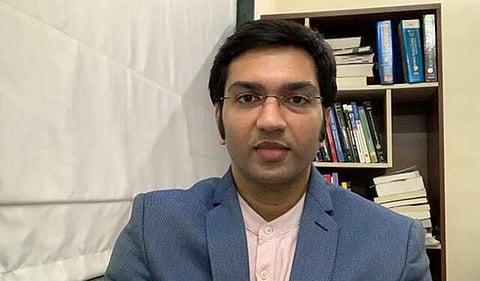

Universal vaccination is the key to fighting a pandemic as large as COVID-19 and it should be our single greatest national priority at present, said Dr Swapneil Parikh, a physician and author of the book The Coronavirus. "We have to do that to scale, diversify our vaccine portfolio, backup distribution and do all of that on a war footing. Everything else is a distraction right now. If we were serious about it, this is what we should have been doing in January-February," he added while speaking at The New Indian Express' online event COVID Think Tank on Tuesday, June 8, 2021. Dr Parikh was speaking on the topic Second Wave: What We Need To Know.
He further emphasised that we are a little too late in realising the importance of vaccines. "This is something we had to do in January. You have to roll out the vaccines in time for them to have maximum impact during the peak, once the peak is done if we roll out vaccines and scale them we aren't maximally benefitting from it. We do have to continue doing it though. It takes time to scale manufacturing and distribution. What they should have done in January on a war footing, manufacturers then said they didn't have demand. When 500 million doses should have been procured at a time, they were making 10-20 million doses. There was no clarity to the manufacturers as we left them with uncertainties. The only focus should have been on scaling, diversifying our vaccine portfolio - more than just the two or three vaccines we have in India now. There has been a lot of lethargy and inertia in thinking that somehow India will have a different reality than others. But now it's a little too late," Dr Parikh explained.
Answering the million-dollar question of where we went wrong, Dr Parikh added, "It was entirely predictable and not something that happened out of the blue, we know that there were more transmissible variants emerging, there were some warning signs even in February there was an uptick in transmission in Maharashtra. Many experts, far more qualified than I am, were raising an alarm about the increase in cases. I was most particularly concerned about the rate of increase and the fact that this is increasing in areas that already had problems, where people had already been infected in the past. This indicated higher transmissibility and immune escape that means the virus is invading our immunity. Now, we know both were true."
So, how did we get here? Responding to that he explained, "When we talk about social distance or physical distance, to suppress transmission you have to look at its use in suppressing future transmission. Ideally the goal is to maximise that like New Zealand, Australia and other countries have done and sustain that until vaccines are rolled out. That's very difficult to do and many countries are struggling to do that. When we do an intensive physical distancing strategy like a lockdown, it occurs when the health systems are unprepared or when we find ourselves in the midst of such catastrophic levels of transmission that our health system is crumbling. Second best would be to have mild persistent physical distancing, masking and if transmission went up, to impose lockdown and have intensive physical distancing at that time. This strategy will still cost a lot of lives, but nothing beats suppression of transmission. The worst possible thing you can do is do a lockdown and then nothing. Then you have given the population suffering due to the lockdown, they have taken that and eventually you have gone from distancing to mass contact, your outbreak size is the same, the scale of epidemic is the same. There is skyrocketing transmission and then it plummets, which is what we are seeing with the second wave. You can never think that the pandemic is over, it means that the control measures work, it means transmission decreased under restrictions. What we did is right from that, after the first lockdown, went to intensive physical contact which is possibly the worst thing you can do. Because that completely obliviates the benefits of the first lockdown. You always have to follow a lockdown with physical distancing that's persistent. And also vaccinate where we messed up at multiple points. The strategy of mitigation and containment, vaccine rollout — we have so many blind spots in our data today. We made mistakes from top to bottom."
Finally, speaking about the five most important things the health ministry needs to do in India currently, Dr Parikh said, "First is vaccines — manufacture, import and distribute and scale up production. Second is testing, it will also prevent infection, identify and isolate, prevent secondary transmission, surveillance-based testing, genomic testing, sewage water testing are all important. Third comes real-time credible data as we can't have blind spots in rural India. Fourth, redistributing healthcare workers from areas of less transmission to areas of higher spread, but this is for the long-term and we need more healthcare workers. Finally, pay attention to air quality, people need to maintain distance and policymakers need to keep policies in place that don't allow mass congregations."
He also assured us that we don't know when things will get back to normal but if we do everything right it could be sooner than a year. "We are going to get back to normal - our ancestors survived pandemics, so we will survive. This is a fight that given us a lot of suffering, we need to acknowledge that first. At least 70-90 per cent eligible adults need to be vaccinated, then we will see things going back to normal. Also realistically look at vaccinating below 18 as well," he concluded.
